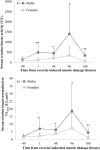Muscle Damage following Maximal Eccentric Knee Extensions in Males and Females
- PMID: 26986066
- PMCID: PMC4795791
- DOI: 10.1371/journal.pone.0150848
Muscle Damage following Maximal Eccentric Knee Extensions in Males and Females
Abstract
Aim: To investigate whether there is a sex difference in exercise induced muscle damage.
Materials and method: Vastus Lateralis and patella tendon properties were measured in males and females using ultrasonography. During maximal voluntary eccentric knee extensions (12 reps x 6 sets), Vastus Lateralis fascicle lengthening and maximal voluntary eccentric knee extensions torque were recorded every 10° of knee joint angle (20-90°). Isometric torque, Creatine Kinase and muscle soreness were measured pre, post, 48, 96 and 168 hours post damage as markers of exercise induced muscle damage.
Results: Patella tendon stiffness and Vastus Lateralis fascicle lengthening were significantly higher in males compared to females (p<0.05). There was no sex difference in isometric torque loss and muscle soreness post exercise induced muscle damage (p>0.05). Creatine Kinase levels post exercise induced muscle damage were higher in males compared to females (p<0.05), and remained higher when maximal voluntary eccentric knee extension torque, relative to estimated quadriceps anatomical cross sectional area, was taken as a covariate (p<0.05).
Conclusion: Based on isometric torque loss, there is no sex difference in exercise induced muscle damage. The higher Creatine Kinase in males could not be explained by differences in maximal voluntary eccentric knee extension torque, Vastus Lateralis fascicle lengthening and patella tendon stiffness. Further research is required to understand the significant sex differences in Creatine Kinase levels following exercise induced muscle damage.
Conflict of interest statement
Figures



References
-
- Lieber RL, Friden J (1993) Muscle damage is not a function of muscle force but active muscle strain. Journal of Applied Physiology 74: 520–526. - PubMed
-
- Warren GL, Lowe DA, Armstrong RB (1999) Measurement tools used in the study of eccentric contraction-induced injury. Sports Medicine 27: 43–59. - PubMed
-
- Clarkson PM, Hubal MJ (2002) Exercise-induced muscle damage in humans. American Journal of Physical Medicine & Rehabilitation 81: S52–S69. - PubMed
-
- Komulainen J, Koskinen S, Kalliokoski R, Takala T, Vihko V (1999) Gender differences in skeletal muscle fibre damage after eccentrically biased downhill running in rats. Acta Physiologica Scandinavica 165: 57–64. - PubMed
Publication types
MeSH terms
Substances
LinkOut - more resources
Full Text Sources
Other Literature Sources
Medical

